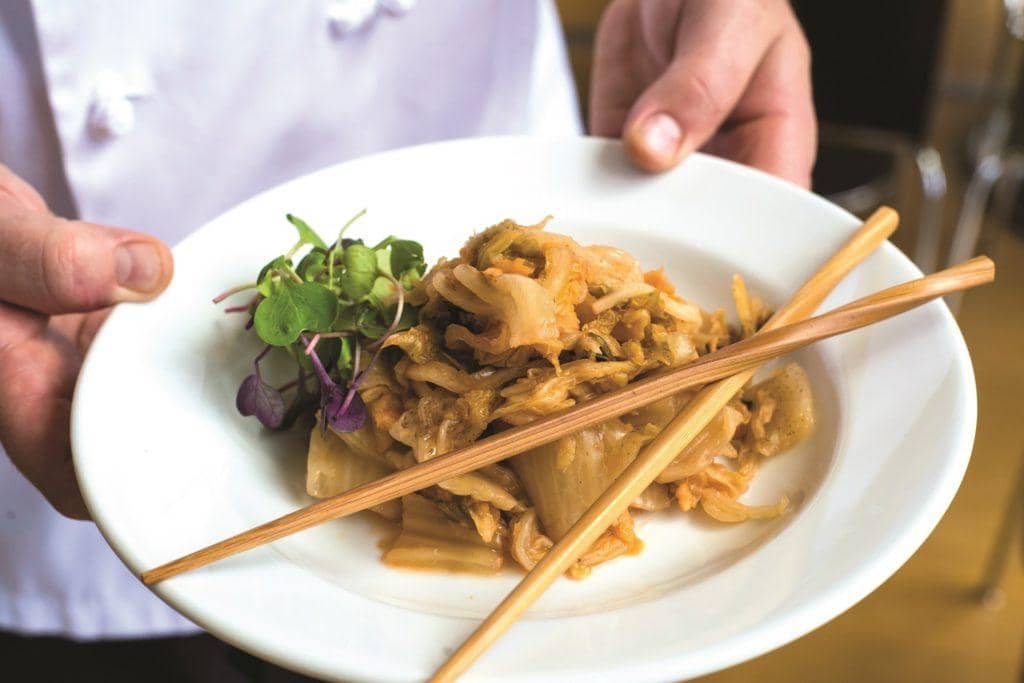Everyone knows there are a whole bunch of microbes living in our bodies, but we don't tend to take care of them. I think that fermented foods tend to make them more content, and that seems to make me happy. Things like kombucha, sauerkraut, kimchi, pickles, tempeh, and kefir seem to give me an energy boost. They are also super delicious!
Here is a recipe for kimchi that we use in the Black Hole Bistro. Kimchi is the ultimate condiment – crunchy, spicy, salty, sour, and sweet. You can put it on almost anything, but a few of my favourites are fried rice, fish dishes, burgers, and tacos.
- Dan Lynch, Black Hole Bistro Manager
Quick and Simple Kimchi
(Modified from thekitchn.com)
Makes 1 quart
What You Need
Ingredients
1 head Napa cabbage (about 2 lb)
1/4 cup sea salt or kosher salt
1 tablespoon grated garlic (about 5-6 cloves)
1 teaspoon grated ginger
1 teaspoon sugar
2 tablespoons fish sauce
3 tablespoons Korean red pepper paste Gochujang
8 ounces daikon, peeled and cut into matchsticks
4 scallions, trimmed and cut into one-inch pieces
Equipment
Cutting board and knife
Large bowl
Gloves
Plate and something to weigh the kimchi down, like a jar or can of beans
Colander
Small bowl
Clean one-quart jar with canning lid or plastic lid
Bowl or plate to place under jar during fermentation
Instructions
1. Prep the cabbage. Slice the cabbage lengthwise into quarters and remove the cores. Cut each quarter crosswise into two-inch-wide strips. Place the cabbage and salt in a large bowl. Using your hands (gloves optional), massage the salt into the cabbage until it starts to soften a bit, then add water to cover the cabbage. Put a plate on top and weigh it down with something heavy, like a jar or can of beans. Let stand for two hours. You are using the salt to extract the water from the cabbage.
2. Rinse and drain the cabbage. Rinse the cabbage under cold water three times and drain in a colander for 15 minutes. Rinse and dry the bowl you used for salting, and set it aside to use in step 5.
3. Make the paste. Combine the garlic, ginger, sugar, and fish sauce in a small bowl and mix to form a smooth paste.
4. Combine the vegetables and paste. Gently squeeze any remaining water from the cabbage and return it to the bowl along with the radish, scallions, and seasoning paste. Mix thoroughly to ensure that the paste covers all the vegetables and cabbage.
5. Pack it in. Pack the kimchi into the jar, pressing down on it until the brine rises to cover the vegetables. Leave at least one inch of headspace. Seal the jar with the lid.
6. Ferment! Let the jar stand at room temperature for one to five days. You may see bubbles inside the jar and some brine may seep out of the lid; place a bowl or plate under the jar to help catch any overflow.
7. Watch, then chill. Check the kimchi once a day, pressing down on the vegetables with a clean finger or spoon to keep them submerged under the brine. (This also releases gases produced during fermentation.) Taste a little at this point, too! When the kimchi tastes ripe enough for your liking, transfer the jar to the refrigerator. You may eat it right away, but it’s best after another week or two.
About PI
Perimeter Institute is the world’s largest research hub devoted to theoretical physics. The independent Institute was founded in 1999 to foster breakthroughs in the fundamental understanding of our universe, from the smallest particles to the entire cosmos. Research at Perimeter is motivated by the understanding that fundamental science advances human knowledge and catalyzes innovation, and that today’s theoretical physics is tomorrow’s technology. Located in the Region of Waterloo, the not-for-profit Institute is a unique public-private endeavour, including the Governments of Ontario and Canada, that enables cutting-edge research, trains the next generation of scientific pioneers, and shares the power of physics through award-winning educational outreach and public engagement.
You might be interested in



